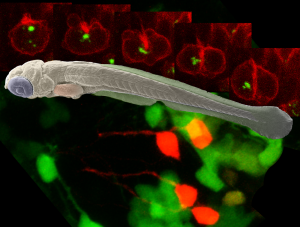Development & Evolution of structural colours in vertebrates
Posted by Michel Milinkovitch, on 3 March 2017
Closing Date: 15 March 2021


PhD position opened in Switzerland for a developmental or cell biologist
Development & Evolution of structural colours in vertebrates
In the context of a multidisciplinary study combining cell biology, evolutionary developmental biology and physics, we offer one PhD student position for an outstanding, highly motivated, and creative experimental wet-lab biologist with strong skills in developmental biology or cell biology.
A major research project in Michel Milinkovitch’s group (Laboratory of Artificial & Natural Evolution; www.lanevol.org) at the University of Geneva (UNIGE) is to better understand the molecular developmental mechanisms generating a diversity of skin colours and patterns in reptiles.
One aim is to understand the development & evolution of surface gratings and intracellular nano-structures generating colours through the physical phenomenon of light interference. The successful candidates will use state-of-the-art microscopy and biochemical/genetic manipulations in both the zebrafish and chameleons to understand the development and evolution of surface gratings and intracellular photonic crystals.
Candidates must have a Master in biology or biochemistry. Skills and experience with developmental biology and/or cell biology are mandatory. The successful candidate will have a genuine interest for organismal biology and will appreciate interactions with developmental biologists, evolutionary biologists, physicists and computer scientists. The PhD student will be localised in the Milinkovitch lab (http://www.lanevol.org) and will have very regular interactions/collaborations with members of Marcos Gonzalez-Gaitan’ lab (https://cms.unige.ch/sciences/biochimie/-Marcos-Gonzalez-Gaitan-Lab-.html).
The University of Geneva is world-renowned for its research in Biology and Physics and is among the top 1% best universities in the world.
PhD students are remunerated according to the standards of UNIGE, which are very generous when compared to other international programs.
Geneva is an international city occupying a privileged geographical situation with its beautiful lake and the close-by Alps.
Refs: Saenko et al. Precise colocalization of interacting structural and pigmentary elements generates extensive color pattern variation in Phelsuma lizards. BMC Biology 2013, 11: 105; Teyssier et al. Photonic Crystals Cause Active Colour Change in Chameleons. Nature Communications 6: 6368 (2015); Tzika et al. Reptilian Transcriptomes v2.0: An Extensive Resource for Sauropsida Genomics and Transcriptomics. Genome Biol. Evol. 7: 1827-1841 (2015); Ullate-Agote et al. The genome sequence of the corn snake (Pantherophis guttatus), a valuable resource for EvoDevo studies in squamates. Int. J. Dev. Biol. 58: 881-888 (2014); Saenko et al. Amelanism in the corn snake is associated with the insertion of an LTR-retrotransposon in the OCA2 gene. Scientific Reports 5, 17118 (2015); Di-Poï & Milinkovitch. The Anatomical Placode in Reptile Scale Morphogenesis Indicates Shared Ancestry Among Skin Appendages in Amniotes. Science Advances 2, e1600708 (2016).
Candidates must send their application — in the form of a single PDF file including a brief letter of interest, a CV, as well as contact information (not support letters) of two persons of reference — to: Prof. Michel Milinkovitch (michel.Milinkovitch@unige.ch).


 (No Ratings Yet)
(No Ratings Yet)